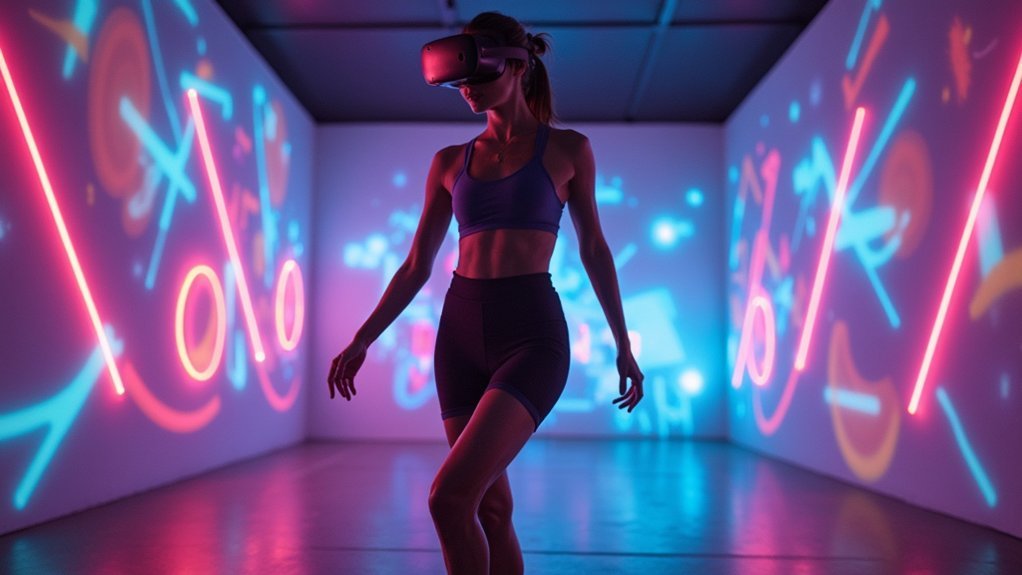You’ll achieve meaningful eye tracking heat map results by defining clear areas of interest before collecting data, ensuring a minimum sample size of 30-50 participants for statistical significance, and properly calibrating your VR hardware for individual differences like interpupillary distance. Account for demographic variations in gaze patterns, combine eye tracking with behavioral metrics like click-through rates, optimize data processing through pixel density filtering, and validate findings across multiple devices. These strategies below reveal deeper user insights.
Define Clear Areas of Interest Before Data Collection

Before you begin collecting eye tracking data, you’ll need to establish specific Areas of Interest (AOIs) that focus your analysis on the most critical regions of your webpage or interface.
Clear AOIs enable precise measurement of user behavior rather than relying on broad, page-wide zones that dilute meaningful insights. Remember that gaze tracking carries a 0.5-1 degree margin of error, making well-defined boundaries essential for accurate data analysis.
Well-defined AOI boundaries compensate for gaze tracking’s inherent margin of error, ensuring your behavioral measurements capture genuine user interactions rather than statistical noise.
Your AOIs should target specific elements like navigation menus, call-to-action buttons, or content sections. This targeted approach helps you identify which components capture attention and which users ignore.
Pre-defined AOIs streamline your eye tracking studies by organizing data collection around actionable insights, ultimately leading to informed design decisions that enhance user experience.
Ensure Adequate Sample Size for Statistical Significance
Statistical power determines whether your eye tracking heat maps reveal genuine user patterns or misleading coincidences. You need adequate sample size to achieve statistical significance and draw reliable conclusions from your gaze behavior data.
Start with 30 participants minimum for basic eye tracking studies. However, detecting subtle differences in fixation patterns requires larger groups. For thorough data analysis, consider 100+ participants when examining small effect sizes.
| Study Type | Minimum Sample Size |
|---|---|
| Basic gaze patterns | 30 participants |
| Demographic comparisons | 50-75 participants |
| Small effect detection | 100+ participants |
| A/B testing interfaces | 60-80 participants |
| Cross-cultural studies | 150+ participants |
Conduct power analysis before data collection to determine suitable sample size based on expected effect sizes. Balance statistical requirements with practical constraints like budget and timeline while ensuring your findings accurately represent user behavior patterns.
Calibrate VR Eye Tracking Hardware Properly
You’ll need proper hardware setup that meets manufacturer specifications before collecting meaningful eye tracking data for your heat maps.
The calibration process requires specific steps to account for individual differences like interpupillary distance and head positioning.
You must validate tracking accuracy across your entire field of view to guarantee your heat map data reflects actual gaze patterns rather than calibration errors.
Hardware Setup Requirements
Precision in VR eye tracking begins with proper hardware calibration, a critical step that determines the accuracy of your entire heat map analysis.
You’ll need a well-lit environment to minimize interference during calibration. Your screen resolution and size settings directly impact tracking precision, so verify these configurations regularly.
Each participant requires individual calibration through following on-screen points that map their unique eye movement patterns. Use calibration patterns featuring both central and peripheral visual targets to accommodate individual differences in peripheral vision.
Before collecting any data, analyze calibration metrics including accuracy and precision scores to confirm successful completion.
This verification step guarantees your eye tracking hardware captures reliable gaze detection data throughout your study, preventing costly inaccuracies in your final heat map results.
Calibration Process Steps
Once you’ve confirmed your hardware setup meets the requirements, begin the calibration process by positioning your VR headset according to the manufacturer’s specifications. Proper calibration guarantees your eye tracking system delivers accurate visual attention data for meaningful heat map generation.
Follow these essential calibration steps:
- Test with multiple users to account for varying eye physiology and visual acuity differences.
- Use clearly visible, appropriately sized calibration targets for focused gaze mapping.
- Adjust settings based on your screen’s size and resolution specifications.
- Re-calibrate regularly throughout sessions, especially when switching between participants.
- Verify calibration accuracy before starting each data collection phase.
These steps establish the foundation for precise eye tracking measurements.
Without proper calibration, your gaze mapping data won’t accurately reflect where participants actually look, compromising your heat map’s reliability and research validity.
Accuracy Validation Methods
After completing your initial calibration sequence, validate accuracy by conducting systematic tests that measure gaze precision against known reference points. You’ll need to verify that your eye tracking system maintains consistent performance throughout your session.
Test your gaze mapping accuracy by having participants look at specific targets while measuring deviation from expected coordinates. Document these measurements to establish baseline performance metrics.
| Validation Method | Target Accuracy | Frequency |
|---|---|---|
| 9-point validation | < 1° deviation | Before each session |
| Corner point test | < 0.8° deviation | Mid-session |
| Random target validation | < 1.2° deviation | Post-calibration |
| Drift compensation check | < 0.5° drift/min | Every 15 minutes |
| Cross-validation test | < 1° average error | Session end |
Recalibrate immediately if validation shows accuracy degradation exceeding acceptable thresholds for reliable data collection.
Account for Individual Differences in Gaze Patterns
While eye tracking heat maps reveal general user behavior trends, they can’t tell the complete story without considering how individual differences shape gaze patterns. Your quantitative data must account for demographic variations to provide actionable insights.
Eye tracking data without demographic segmentation only scratches the surface of true user behavior patterns.
Research shows significant variance in how different groups interact with content:
- Male and female visitors focus on different web page elements
- Age and visual acuity affect fixation duration on specific areas
- Cognitive load impacts how users process information density
- Time To First Fixation varies between demographic segments
- Personal interests influence navigation patterns and engagement levels
You’ll need to segment your eye tracking analysis by key demographics rather than treating all users identically.
This approach reveals whether certain elements work better for specific audiences, enabling you to create personalized experiences that enhance engagement and optimize content placement for individual user needs.
Combine Eye Tracking With Behavioral Metrics
Segmenting your eye tracking data by demographics gives you valuable insights, but you’ll reveal the full potential of your analysis when you pair this visual data with concrete behavioral metrics.
Combining eye tracking heat maps with click-through rates and conversion data creates a thorough picture of user engagement that demographics alone can’t provide.
Analyze your heatmaps alongside scroll depth metrics to identify which sections maintain attention and which hurt content visibility.
When you integrate time spent on elements with gaze fixation durations, you’ll discover ideal CTA positioning that drives interactions.
Don’t stop there—correlate your eye tracking findings with qualitative survey data.
This combination reveals visitor motivations behind the patterns, enabling you to make informed design decisions that boost website performance and overall user experience.
Optimize Data Processing and Filtering Techniques
Since raw eye tracking data contains substantial noise and irrelevant information, you’ll need robust processing techniques to extract meaningful insights from your heat maps.
Effective data visualization requires strategic filtering methods that transform chaotic gaze patterns into clear behavioral data representations.
Key processing techniques for ideal heat maps include:
- Pixel density filtering – Remove noise while highlighting significant gaze points for clearer user behavior patterns
- Area of Interest (AOI) definitions – Isolate specific webpage regions to focus on targeted interactions
- Fixation duration metrics – Distinguish between fleeting glances and sustained attention periods
- Advanced analysis tools – Utilize software with statistical capabilities and comparative visualization features
- Regular recalibration – Validate processing methods as user behavior patterns evolve over time
These techniques guarantee your heat maps accurately reflect genuine user engagement rather than meaningless data scatter.
Validate Findings Through Cross-Platform Testing
Although heat map data from a single platform provides valuable insights, you’ll achieve more reliable results by testing your findings across multiple devices and environments. Cross-platform testing validates your heat maps by revealing whether user behavior patterns remain consistent across desktop, mobile, and tablet interfaces.
| Platform Type | Key Validation Focus |
|---|---|
| Desktop | Screen resolution variations |
| Mobile | Touch interaction patterns |
| Tablet | Orientation-based behaviors |
| Different Browsers | Element rendering differences |
| Operating Systems | Interface responsiveness |
This thorough analysis approach helps you identify platform-specific user experience issues that single-device testing might miss. When your heat maps show consistent interaction patterns across platforms, you can confidently implement design optimizations. Conversely, discrepancies signal the need for platform-specific adjustments to maximize user engagement effectiveness.
Frequently Asked Questions
How to Make Eye-Tracking Better?
You’ll improve eye-tracking by properly calibrating equipment, defining specific Areas of Interest, combining multiple metrics like heat maps and fixation data, using statistical analysis, and conducting thorough pilot tests before full studies.
When Visualizing Eye-Tracking Results Through Heat Maps?
You’ll want to clearly define your Areas of Interest first, then apply a warm-to-cool color spectrum where red shows high engagement and blue indicates minimal user interaction.
What Is the Best Way to Make Heat Maps?
You’ll create effective heat maps by properly calibrating your eye-tracking equipment, using clear grid overlays with hot colors for high engagement, and combining multiple map types like click and scroll maps.
What Are Two Key Measures for Eye-Tracking?
You’ll focus on two key measures when analyzing eye-tracking data: gaze, which tracks your general visual attention direction, and fixation, which measures sustained focus on specific points lasting over 100 milliseconds.
In Summary
You’ll transform your eye tracking heat map projects by implementing these seven essential strategies. Don’t underestimate the power of proper preparation—defining your areas of interest and calibrating hardware correctly sets you up for success. Remember that combining eye tracking with behavioral data gives you the complete picture you’re after. When you validate findings across platforms and account for individual differences, you’ll generate insights that truly drive meaningful decisions and measurable results.





Leave a Reply